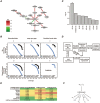A novel Bayesian network inference algorithm for integrative analysis of heterogeneous deep sequencing data
- PMID: 23318583
- PMCID: PMC3587713
- DOI: 10.1038/cr.2013.8
A novel Bayesian network inference algorithm for integrative analysis of heterogeneous deep sequencing data
Figures

References
Publication types
MeSH terms
LinkOut - more resources
Full Text Sources
Other Literature Sources

